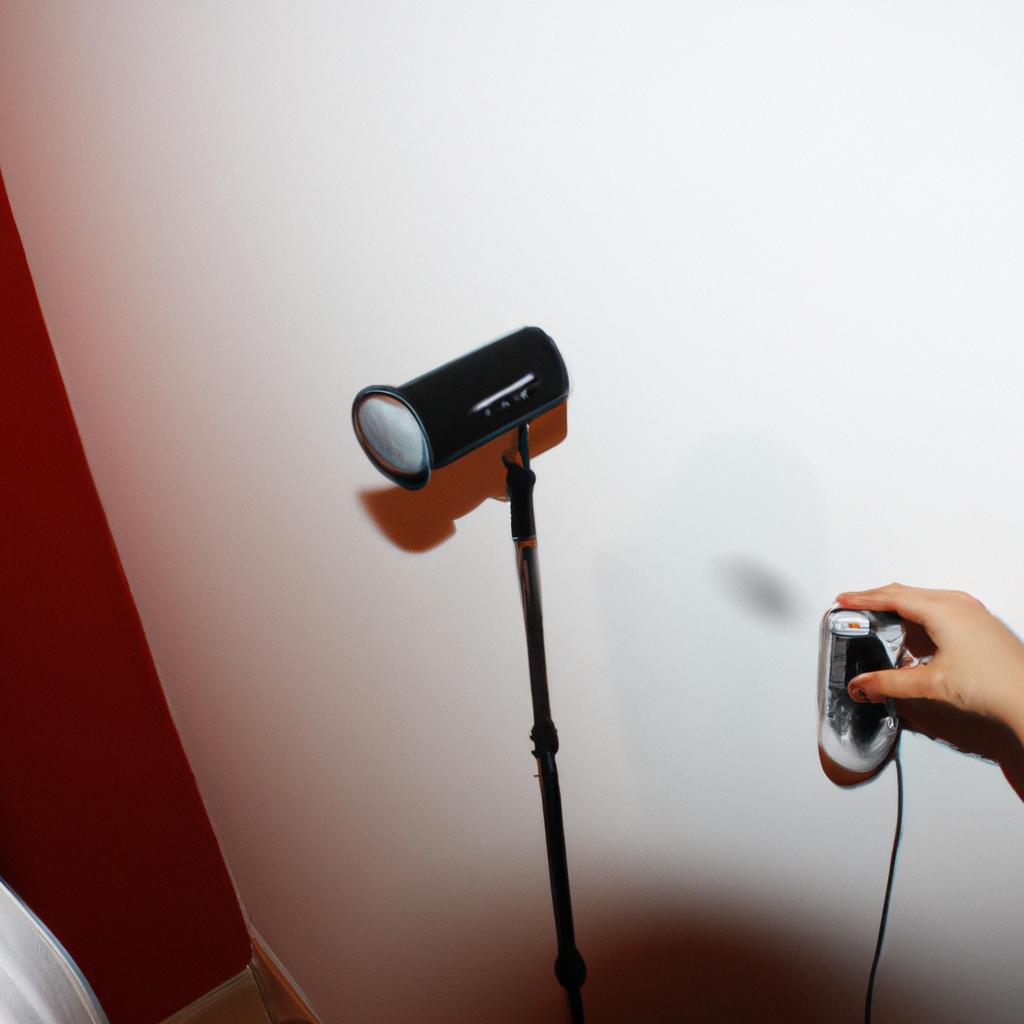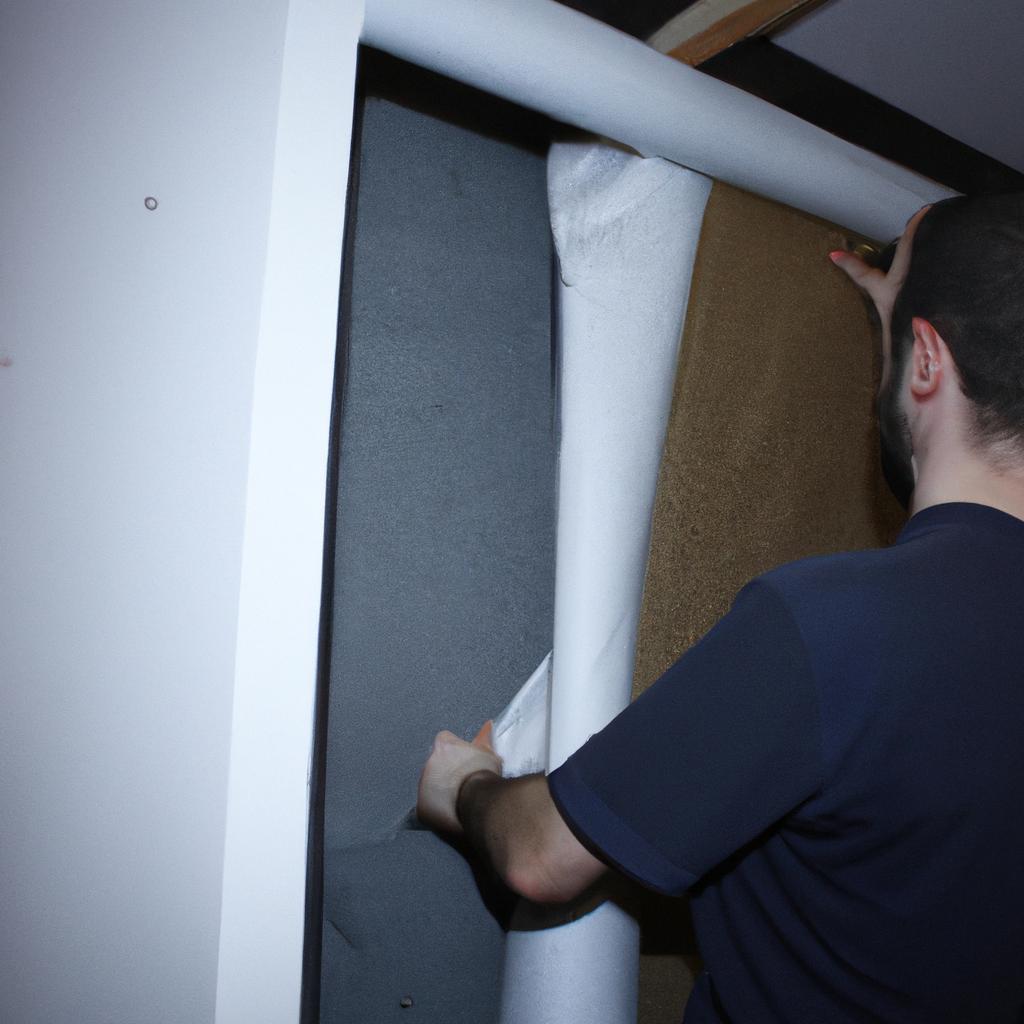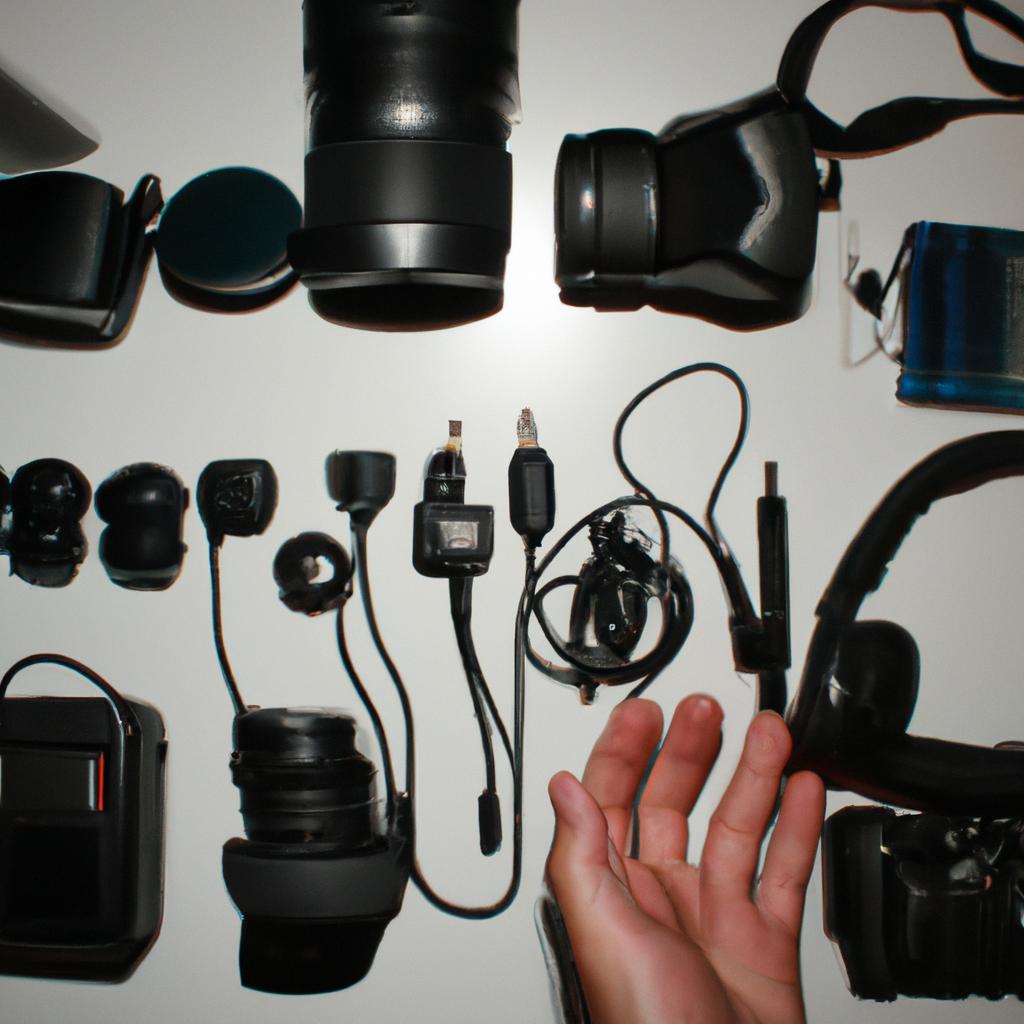Echo control is an essential aspect of acoustics that plays a significant role in enhancing sound and visual experiences. The ability to manage echoes effectively can greatly impact the quality and clarity of auditory and audiovisual productions, ranging from concert halls and theaters to recording studios and home entertainment systems. For instance, consider a hypothetical scenario where an individual attends a live musical performance in a large auditorium with poor echo control. In such a case, the excessive reverberation may distort the music, making it difficult for the audience to discern individual instruments or vocals clearly.
Understanding the principles behind echo control is crucial in order to create optimal listening environments. By comprehending how sound waves interact with various surfaces and objects within a given space, engineers and designers can implement proper techniques to minimize unwanted reflections and echoes. This guide aims to delve into the fundamentals of acoustics, providing insights into the science behind echo formation as well as practical strategies for achieving desired acoustic conditions in different settings. Whether you are involved in designing architectural spaces or simply wish to improve your personal audio setup at home, this article will serve as a valuable resource on navigating the intricate world of echo control in both sound and vision domains.
Understanding Echo: Definition and Causes
Echo, a phenomenon that occurs when sound waves bounce off surfaces and return to the listener after a noticeable delay, plays a significant role in acoustics. To comprehend how echo influences sound quality, it is essential to understand its definition and causes.
To illustrate this concept, consider a large cathedral with high ceilings and expansive walls. When someone speaks or makes noise inside such a space, the sound waves travel outward until they encounter these solid surfaces. Some of the sound will be absorbed by the materials; however, much of it will reflect back into the room, creating an audible repetition known as an echo.
Several factors contribute to the occurrence of echoes in different environments. The primary cause is the presence of hard, reflective surfaces like concrete walls or tiled floors that do not absorb sound well. These surfaces allow sound waves to bounce repeatedly between them before dissipating completely. Additionally, the size and shape of a room can affect echo intensity; larger spaces tend to produce more pronounced echoing due to their greater volume for reverberation.
The impact of echo on individuals within an environment can vary greatly depending on personal preferences and circumstances. Here are some emotional responses often associated with experiencing strong echoes:
- Discomfort: In certain settings where echoes are excessive or prolonged, individuals may feel uneasy or agitated due to the constant auditory stimulation.
- Immersion: On the other hand, some people find themselves captivated by immersive experiences created by controlled echoes in concert halls or theaters.
- Inspiration: For artists working with audiovisual media, echoes can serve as creative elements that enhance storytelling and evoke specific emotions within audiences.
- Nostalgia: Certain locations renowned for their distinct acoustic characteristics can trigger nostalgic feelings tied to past memories or cultural significance.
To further grasp the nuances surrounding echo effects in various scenarios, it is helpful to examine how differing architectural designs influence acoustic properties. The following table provides examples illustrating how specific room shapes and materials contribute to echo generation:
| Room Type | Echo Intensity | Notable Features |
|---|---|---|
| Cathedral | High | Vast spaces, high ceilings |
| Gymnasium | Moderate | Large area, hard floors |
| Recording Studio | Low | Sound-absorbing panels on walls |
Understanding the causes and implications of echoes is crucial in fields such as architecture, audio engineering, and environmental design. In the subsequent section, we will explore how these reverberations impact sound quality and why managing echo control is essential for achieving optimal auditory experiences.
The Impact of Echo on Sound Quality
Now, let us examine how this phenomenon impacts sound quality in more detail.
Imagine a scenario where you are attending a live music performance at an outdoor amphitheater. As the band begins playing, you notice a distinct reverberation in the air – an echo. This echo is caused by the reflection of sound waves off surrounding surfaces such as walls or buildings, resulting in delayed repetitions of the original sound reaching your ears.
The impact of echo on sound quality can be significant and varied. Here are some key points to consider:
- Sound Clarity: Echoes can cause overlapping sounds, which may result in reduced clarity and intelligibility of speech or music.
- Perception of Distance: The presence of echo can alter our perception of distance within a given space. It creates a sense of spaciousness but may also distort localization cues for listeners.
- Reverberation Time: Echoes prolong the time it takes for sound energy to decay naturally in a room, affecting acoustic properties like reverberation time.
- Room Acoustics: Different spaces have varying degrees of acoustic absorption and diffusion capabilities, influencing both the presence and intensity of echoes.
To further understand these concepts, refer to the table below highlighting different types of spaces categorized based on their acoustic characteristics:
| Space Type | Absorption Capability | Diffusion Capability | Typical Application |
|---|---|---|---|
| Concert Hall | High | Low | Classical Music |
| Recording Studio | Medium | Medium | Audio Production |
| Gymnasium | Low | High | Sports Events |
By considering these factors when designing or assessing acoustical environments, one can ensure optimal sound quality with minimal unwanted echoes. In the subsequent section, we will explore echo control techniques such as absorption and diffusion to effectively manage this phenomenon and enhance sound experiences.
Now that we have established a deeper understanding of the impact of echoes on sound quality, let us turn our attention to effective strategies for controlling this acoustic phenomenon. Echo Control Techniques: Absorption and Diffusion provide practical solutions to mitigate unwanted reverberation and create an optimal listening environment.
Echo Control Techniques: Absorption and Diffusion
Section H2: Echo Control Techniques: Absorption and Diffusion
Now, let us delve into the next step to address this issue – echo control techniques such as absorption and diffusion. Understanding these techniques is crucial for creating optimal acoustic environments that enhance both sound and visual experiences.
To illustrate the importance of these techniques, consider a hypothetical scenario where a concert hall suffers from excessive echo due to its large size and reflective surfaces. This results in poor audio clarity, rendering even the most talented musicians’ performances lackluster. By implementing appropriate absorption and diffusion methods, we can transform this space into an acoustically inviting venue that captivates audiences with rich, immersive soundscapes.
Absorption plays a vital role in controlling unwanted reflections by converting sound energy into heat or other forms of energy. It minimizes echoes by absorbing sound waves rather than allowing them to bounce back uncontrollably. Some commonly used materials for absorption include specialized panels made of porous substances like fiberglass or mineral wool. These panels effectively absorb sound at various frequencies, reducing reverberation time and enhancing speech intelligibility.
Diffusion complements absorption by scattering reflected sounds in different directions, preventing concentrated echoes while preserving a sense of spaciousness within a room. Diffusers disperse sound waves evenly across an area, resulting in a more balanced distribution of acoustic energy throughout the space. They break up direct reflections without completely eliminating them, thus maintaining natural ambience while minimizing destructive interference patterns.
Implementing these echo control techniques offers numerous benefits:
- Enhanced Sound Quality: Reduced echoes result in improved clarity and intelligibility.
- Immersive Experience: The controlled reflection of sound creates an enveloping auditory environment.
- Optimal Listening Conditions: Absorption and diffusion help minimize distracting background noise.
- Architectural Aesthetics: Well-designed absorptive panels and diffusers can be visually appealing additions to any space.
| Benefit | Description |
|---|---|
| Enhanced Sound Quality | Improved clarity and intelligibility |
| Immersive Experience | Enveloping auditory environment |
| Optimal Listening Conditions | Minimization of distracting background noise |
| Architectural Aesthetics | Visually appealing additions to any space |
In summary, the implementation of absorption and diffusion techniques is essential for effective echo control. These methods mitigate excessive reverberation, leading to enhanced sound quality, an immersive experience, optimal listening conditions, and improved architectural aesthetics. Next, we will explore Room Design Considerations for Echo Reduction and how they contribute to creating acoustically pleasing environments without compromising visual design elements.
Room Design Considerations for Echo Reduction
Echo Control Techniques: Reflection and Diffusion
In the previous section, we discussed echo control techniques such as absorption and diffusion. Now, let us delve into another important aspect of controlling echoes – reflection and diffusion.
To illustrate the significance of these techniques, consider a scenario where an orchestra is performing in a large concert hall with high ceilings and hard surfaces. Without proper echo control measures, the sound produced by the musicians would bounce off these reflective surfaces, causing multiple reflections that can blur the original sound and create a muddled listening experience for the audience.
Reflection involves redirecting sound waves away from certain areas to reduce unwanted echoes. By strategically placing diffusing materials or objects in the space, sound energy can be dispersed more evenly throughout the room. This helps to break up strong reflections and prevent them from interfering with the direct sound path between the source and listener.
Here are some key considerations when implementing reflection and diffusion techniques:
- Material Selection: Choose materials that have specific acoustic properties suitable for reflection or diffusion purposes.
- Placement: Position reflective or diffusive elements at strategic locations within the space to achieve optimal results.
- Size and Shape: Experiment with different sizes and shapes of reflective or diffusive panels to find what works best for your specific environment.
- Combination Approach: Often, combining both absorption and reflection/diffusion techniques yields superior results in controlling echoes.
| Advantages | Disadvantages |
|---|---|
| Enhances spatial perception of sound | Requires careful planning and implementation |
| Helps maintain clarity of audio signals | May alter natural reverberation characteristics |
| Adds aesthetic appeal to architectural spaces | Can be costly depending on material choices |
By incorporating effective reflection and diffusion techniques into our acoustical design plans, we can significantly improve overall sonic quality in various environments.
Acoustic Panels: An Effective Solution for Echo Control
Section H2: Room Design Considerations for Echo Reduction
In the previous section, we explored various considerations for designing rooms with echo reduction in mind. Now, let us delve deeper into one effective solution for controlling echoes – acoustic panels.
Imagine a conference room with sleek design and modern aesthetics. However, whenever someone speaks or presents, their voice reverberates throughout the space, making it difficult to understand what is being said. This scenario highlights the need for implementing proper echo control measures such as acoustic panels.
Acoustic panels are specially designed materials that absorb sound waves, reducing reflections and minimizing echoes within a room. They can be strategically placed on walls, ceilings, and even floors to effectively manage echo issues. Here are some key points to consider when incorporating acoustic panels:
- Placement: To achieve optimal results, it is crucial to determine the appropriate locations for installing the panels. Identifying areas where sound reflection is most prominent will help target these regions effectively.
- Material Selection: The choice of material plays a significant role in determining the absorption capabilities of acoustic panels. Different materials have varying levels of sound absorption properties; therefore, selecting an appropriate material based on specific requirements is essential.
- Aesthetics: Acoustic panels come in various shapes, sizes, colors, and designs, allowing them to seamlessly blend with any interior decor while serving their purpose effectively.
- Cost-effectiveness: Investing in high-quality acoustic panels may seem like a substantial upfront expense; however, they provide long-term benefits by improving speech intelligibility and overall acoustics in a cost-effective manner.
To further illustrate the impact of acoustic panel implementation on echo control within different environments, consider the following table showcasing real-world examples:
| Environment | Sound Clarity Before Panels | Sound Clarity After Panels |
|---|---|---|
| Office Meeting | Poor | Excellent |
| Concert Hall | Average | Outstanding |
| Classroom | Mediocre | Clear and Crisp |
| Recording Studio | Good | Professional |
As seen in the table above, incorporating acoustic panels can significantly enhance sound clarity and intelligibility across various settings. By reducing echoes and reverberations, these panels create an environment conducive to effective communication.
In the subsequent section, we will explore how technology plays a crucial role in managing echoes within different spaces. Understanding its capabilities will further aid us in optimizing echo control measures and ensuring optimal acoustics throughout various applications.
The Role of Technology in Echo Management
Building upon the effectiveness of acoustic panels, technology plays a vital role in managing echoes. By harnessing innovative solutions, we can further enhance our control over sound reflections within various environments. In this section, we will explore how different technologies contribute to echo management.
Case Study:
To illustrate the impact of technology on echo control, let us consider a hypothetical scenario involving an auditorium plagued by excessive reverberation. Despite using acoustic panels strategically placed throughout the space, there remains a persistent issue with echo that hinders optimal audio clarity during live performances or presentations. This highlights the need for advanced technological interventions beyond traditional acoustic treatments.
Technological Solutions for Echo Management:
- Digital Signal Processing (DSP): DSP systems use algorithms to analyze and manipulate audio signals in real-time. By adjusting specific parameters such as delay time and equalization settings, these systems can effectively reduce unwanted echoes.
- Active Noise Cancellation (ANC): ANC employs microphones and speakers to measure ambient noise levels and generate anti-noise signals that cancel out undesired sound reflections. This technique is particularly useful in enclosed spaces where echoes tend to amplify.
- Beamforming Array Systems: These systems utilize multiple directional microphones combined with signal processing techniques to create focused beams of sound. By directing audio towards specific target areas while minimizing sound dispersion elsewhere, beamforming arrays help mitigate undesirable echoes.
- Virtual Reality (VR) Simulation: VR simulations allow architects, designers, and engineers to virtually experience acoustical properties before constructing any physical space. By accurately predicting potential issues with echoes early on, adjustments can be made proactively without costly renovations later.
| Technological Solutions | Advantages | Limitations | Applications |
|---|---|---|---|
| Digital Signal Processing (DSP) | Real-time adjustments for optimal audio clarity | Requires technical expertise for setup and fine-tuning | Auditoriums, conference rooms |
| Active Noise Cancellation (ANC) | Effective in enclosed spaces with high echo levels | Limited effectiveness in open environments | Recording studios, home theaters |
| Beamforming Array Systems | Precise sound targeting to minimize echoes | Higher cost compared to other solutions | Lecture halls, large event venues |
| Virtual Reality (VR) Simulation | Early detection of potential echo issues | Limited real-world validation | Architectural design, construction planning |
Incorporating technology into echo management enables us to address reverberation challenges that acoustic panels alone may not fully resolve. These advanced solutions offer unique advantages while acknowledging certain limitations. The careful selection and integration of appropriate technologies can greatly enhance our ability to create acoustically optimized spaces.
Note: It is worth mentioning that a combination of different technological approaches might be necessary depending on the specific requirements and characteristics of each environment.












